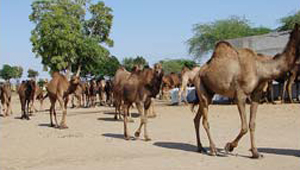Bikaner Sightseeing
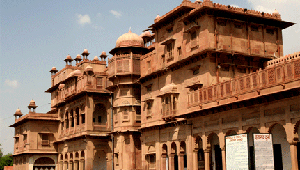
The wonderful architectural piece was built between 1588 -1593 AD by Raja Rai Singh (1571 - 1611 AD) , a general in army of Mughal emperor, Akbar. The imposing fort has 986 long wall with 37 bastions and two entrances. The Suraj Pole (Sun Gate) is main entrance to the fort. The palaces within the fort are on the southern side and make a picturesque ensemble of courtyards, balconies, kiosks and windows.A measure feature of Junagarhfort is the superb quality of the stone carving-it rivals the best anywhere in the world. Among the places of interest are the Chandra Mahal, or Moon Palace, with paintings, mirrors and carved marble panels. The Phool Mahal or Flower Palace is decorated with glass and mirrors.The Karan Mahal was built to commemorate a notable victory over the Mughal Aurangzeb. The Anoop Mahal is famous for it's gold leaf painting. Other palaces worth visiting are the Dungar Niwas, Ganga Nivas, Gaj Mandir, Rang Mahal, Bijai Mahal. Gigantic columns, imposing arches and graceful scenes, minarets and pavilions, in fact, make it worth a repeat visit.
Lallgarh Palace
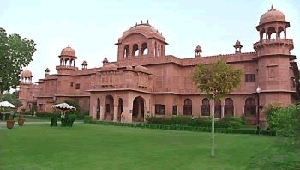
The architectural masterpiece in red sandstone, built by Maharaja Ganga Singh (1881 AD-1942 AD) in memory of his father Maharaja Lall Singh between 1902 -1926.This magnificent palace is an example of pure Rajput martial architecture. Designed by Sir Swinton Jacob, this palace has several grand halls, lounges, cupolas and pavilions.The exotic palace has magnificent pillars, richly carved fire mantles, Italian colonnades and motif of lotus in full bloom, adding to the magic of this color full Palace.
Gajner Palace
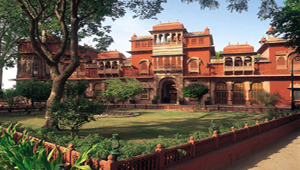
Khuldabad is a very important significant religious centre. The place is abode to 2 of the most worshiped Muhammaden saints. Burhan-ud-din and Zain-ud-din are the most worshiped Muhammaden saints and their tombs are also situated here.
The architecture of Gajner palace is truly outstanding. Built in red sandstone with intricately carved pillars, jharokhas and screens , the craftsmanship here is amazing.Palace is surrounded by beautiful wooded area, now a preserved sanctuary which provides shelter to chinkaras, blackbucks, blue bull (neel gai) and flocks of imperial sand grouse. A part of palace has been transformed into hotel.
Karni Mata Temple (Rats temple)
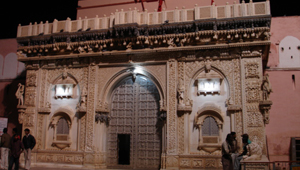
Situated en route to Jodhpur, the temple is dedicated to Karni Mata -an incarnation of Durga. The temple has fascinating huge silver gates and marble carvings that were donated by Maharaja Ganga Singhji The most attractive feature of temple are the rodents who scamper freely within the premises and if one touches your feet its considered auspicious. They are regarded sacred and devotees buy prasad (feeding) to offer to them.The Karni Mata Temple is dedicated to a 15th century local saint who is believed to be an incarnation of Goddess Durga.
Bhandeshwar and Sandeshwar Temples
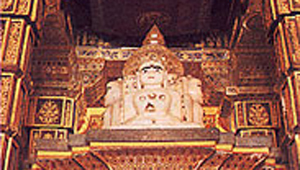
Located on the outskirts of Bikaner, these 14th century temples are major tourist attraction in Bikaner.These temples are constructed by two brothers Bhandeshwar & Sandeshwar which were named after them. Bhandeshwar & Sandeshwar Temples are famous for their impressive carvings, astonishing wall paintings, admirable gold leaf paintings and rich mirror work.
Shiv Bari Temple
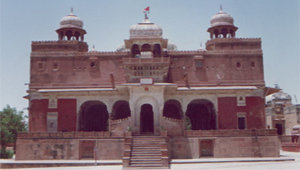
Shiv Bari Temple (6 kms from Bikaner) Fortified by a high wall the temple is dedicated to Lord Shiva. Maharaja Doongar Singh constructed it in the ninth century in the memory of his father Maharaj Lall Singhji. The temple has a beautiful wall panting of Nandi Bull facing the Shiva Lingam. This is located on the way to the camel town.The Shiv Bari Temple attracts the maximum number of visitors during the month of February. Besides, the temple is always crowded on Mondays when the local populace visit the temple.
Bhaironji Temple
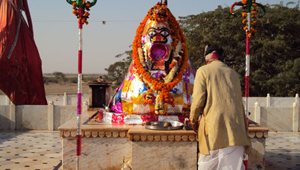
Bhaironji Temple located at Kodamdesar near Bikaner in Rajasthan, India is definitely one of the most important places to see in this part of Rajasthan, India.
Ganga Singh Museum
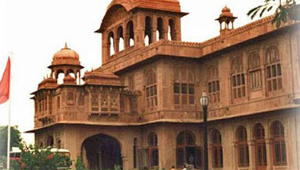
This museum is popularly described as the best museum in the state, it displays a rich array of archaeological discoveries from prehistoric Harrapan and early Gupta period. Ganga Singh Museum is considered to be the best in Rajasthan for its treasure trove of artefacts from Harappan and Gupta periods. Paintings, terracotta, carpets, pottery, art and crafts, and Rajput weapons are on display.
Sun Gate
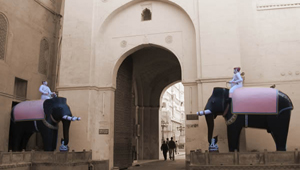
It is the main entrance to the fort. Among the notable of these palaces are the exquisitely beautiful Chandra Mahal or the Moon Palace with marvelous paintings, mirrors and carved marble panels, and the Phool Mahal or Flower Palace ornate with glass and mirror work. Other palaces worth visiting are the Anup Mahal, Karan Mahal, Dungar Niwas, Ganga Niwas, Gaj Mandir and Rang Mahal, Gigantic columns, arches and graceful screens adorn the palaces from within.
Kalibangan
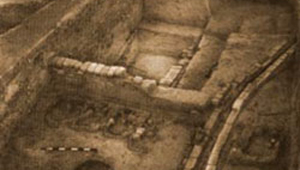
Nestled at 205-km away from Bikaner, Kalibanga, is located in Hanumangarh district of Rajasthan. Situated on the left bank of the Ghaggar (Ancient Saraswati) river, usually dry but occasionally flooded, at a distance of about 5 km from Pilibanga Railway Station, Kalibangan has equal Historical importance like Harappa and Mohenjo-daro. Saraswati was a part of the Indus River system. Historic ruins at Kalibangan can be seen as excursions from Bikaner that keeps high importance for the people who have interest in history. Kalibangan has cosmic historical importance as it was an important part of the ancient Indus Valley Civilization that flourished during 3000 B.C. to 5000 B.C.
Shri Sadul Museum
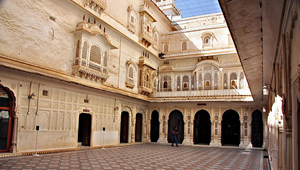
Shri Sadul Museum is located at Lalgarh Palace, the red sandstone palace located in Bikaner. It is housed in the Ganga Niwas, which covers the entire first floor of the palace. The museum displays a unique collection of miniature paintings, manuscripts, weaponry and old photos depicting royal hunts. It also houses the personal possessions of former Bikaner rulers, which includes golf tees, camera, clothes, books and earplugs. The museum is open daily from 10:00 to 17:00 hrs, except on Wednesdays. It can be visited on a small entrance fee. Photography is not allowed. Shri Sadul Museum is about 3 km from Bikaner Junction Railway Station and 2 km north of downtown area.
The Rajasthan State Archives

The Rajasthan State Archives in Bikaner is one of the most worth visiting spots and is counted among the top Museums and Galleries in Rajasthan. It holds some very invaluable administrative records of Mughal Period such as Persian Farmans, Nishans, Manshurs, Akbarat, Vakil Report, Arzdasht and Khatoot. It also contains interesting records that were created during the administration of the Princely states of Rajasthan such as Bahiat, Pattas, Parwanas, Rukkas, Chithiat and so on.The Bikaner Rajasthan State Archives is obviously one of the very famous tourist spots for housing unmatched and truly priceless collection of records. The record it holds is very significant to researchers all over the world. Besides, this custodian of ancient records also offers amazing facilities like microfilming, reference library and research rooms which help researchers immensely. This apart, it also exhibits few very important documents to serve the tourist interest.
Katariasar Village
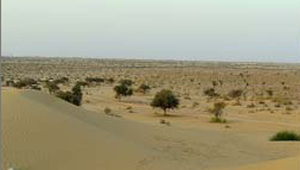
Situated approximately 45 km from Bikaner, on the Jaipur road, is the Katariasar village. The village provides a window into the ethnic rural and cultural life of Rajasthan. The village has a rich wildlife around it, consisting of Chinkara, Desert fox, Rabbit, Peacock, Parrot, Pat, etc. this village is also famous for its fire dancers, performing to the beat of drums on a bed of burning coals.
Devi Kund
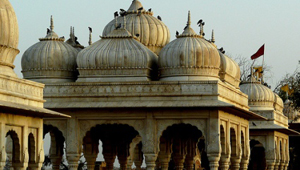
Devi-kund, the Royal crematorium, is a world class example of architectural marvels of Historical India. Devi-kund is the site of royal cenotaphs (called Chattri in the local language) of the Bikaji Rathores, the great rulers of the Bika dynasty. Reflecting the Rajputana architectural style, the Devi-kund chattris steal the hearts of tourists.There are several chattris,Each Chhatri is dedicated to the memory of rulers of Bikaji dynasty and is situated on the exact place where they were cremated. The Chhatri of Maharaj Surat Singh is a fine example of architecture. The ceilings of the Chhatris displays some delicate Rajput paintings.
Gajner Wildlife Sanctuary
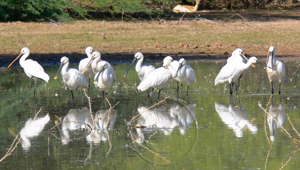
This reserve and the forested hills are 32 km from Bikaner on the Jaisalmer road, are inhabuted by wildfowl, hares , wild boar, desert foxes and a number of deer and antelopes including blackbucks and bluebulls. The lake at Gajner attracts water birds in thousands. Imperial sand gouse migrate here in winter. Gajner Wildlife Sanctuary, houses the former Hunting lodge of Bikaner and has a beautiful lake surrounded by a dense forest.
There is no other infrasturcture or accomodation for infrasturucture for Visitors except Gajner Palace Hotel and, there are no authorised guides at the sancuary. The reserve is only accesible through Gajner Palace Hotel vehicles( which can be hired by the non-guests aslo). Jeeps can take maximum six people.
Kolyatji
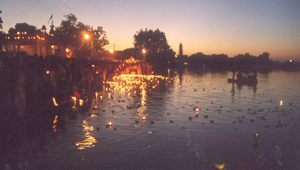
Kolyat is located 50 kilometres from Bikaner. It is a temple complex of Kolyat and a holy place of pilgrimage for Hindus. The legend has it that Kapil Muni the advocate of Shankya yoga of the Hindu philosophy while journeying towards northwest was struck by the tranquility and peace of this place and chose to perform tapasya (penance) here for the redemption of the world. This place has since acquired great sanctity. The complex has several temples, pavilions and bathing ghats. A dip in the holy waters of the lake especially on Kartik Poornima (November) is considered very auspicious.
